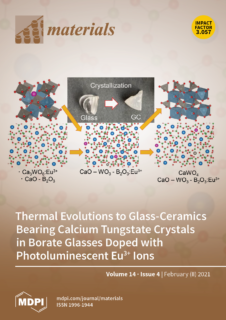GRK2495/G scientists provide novel insights into the stabilization of calcium tungstate crystals in an amorphous borate matrix containing red-luminescent Eu3+ ions.
Lead-free double perovskites have a high structural and chemical flexibility. Thus, these compounds have drawn significant attention for their possible applications, especially in photovoltaics and optoelectronics. In this study, we considered the possibility of developing non-porous materials having functional crystals embedded in a glass matrix (glass-ceramics) and, in particular, the stabilization of calcium tungstate crystals in an amorphous borate matrix containing red-luminescent Eu3+ ions. There are two types of calcium tungstate crystals of interest as rare-earth phosphors: the tetragonal CaWO4 and the monoclinic Ca3WO6. The main question for developing a red-emitting phosphor is wherever Eu3+ ions are finally positioned after the crystals‘ precipitation in glass-ceramics based on calcium tungstates.
Otsuka, T., Brehl, M., Cicconi, M.R., de Ligny, D., & Hayakawa, T.:
Thermal Evolutions to Glass-Ceramics Bearing Calcium Tungstate Crystals in Borate Glasses Doped with Photoluminescent Eu3+ Ions
In: Materials 14(4), 952 (2021)
https://doi.org/10.3390/ma14040952.
Within the IRTG NITech-FAU collaboration, glass-ceramics thermal evolution was investigated to develop luminescent glass-ceramics using Eu3+ ions in a borate glass matrix with calcium tungstates crystals. The joined effort resulted in a recent publication (Otsuka et al. 2021) that was also featured on the journal issue’s cover. Mr. Takahito Otsuka, who already spent three months at FAU in Erlangen, is a student in Prof. Hayakawa’s group and is currently under evaluation as a Ph.D. candidate for Project G.
All publications published within the IRTG can be found here.

